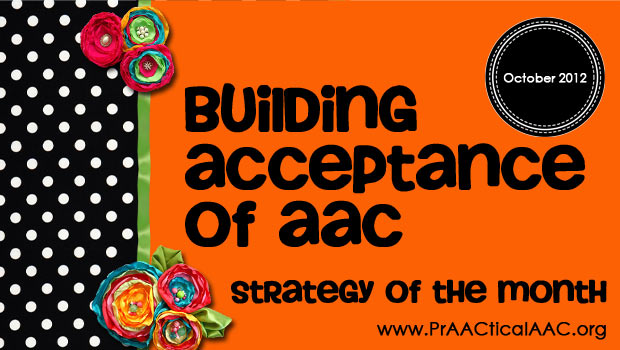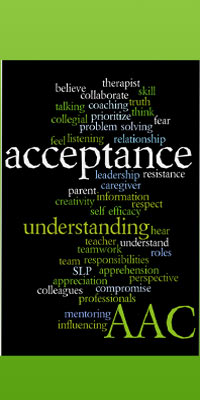Strategy of the Month: Building Acceptance of AAC

Since October is AAC Awareness Month, we wanted to focus on a topic that applies to everyone. No matter what age group or client population you work with, no matter what the service delivery setting is, you probably find yourself needing to build acceptance for implementation of AAC tools and strategies. So this month we’ve decided to share strategies for helping others see things the AAC way. We’ll talk about strategies for attitudinal, knowledge, and access barriers.
To get us started, we consider a medical scenario in which Catherine visits her doctor, complaining of a sore throat. To determine the treatment, the physician first tries to identify the cause of Catherine’s discomfort and looks for the most common causes of sore throat. Allergies, infection, vocal abuse. Each cause triggers different treatment options for considerations. Antibiotics for allergies? Not likely to be effective. Antihistimines for vocal abuse? Nope. Knowing the root of the problem, allows Catherine’s doctor to recommend an appropriate treatment
The same approach is helpful when we encounter (or even anticipate) resistance to AAC. Understanding the cause helps us select an appropriate course of action to pursue.
In a perfect world, we’re supporting a person’s AAC journey in a climate of acceptance. In the real world, however, we often have to do a good bit of work to get some of the stakeholders to buy into the process. The first step may be simply taking the time to reflect on the situation so that we can more clearly understand and define the issues.
- Who am I trying to persuade?
- To what are they resistant? As best you can, try to define the scope of what they’re resistant to. Are they opposed to AAC in general? To a specific strategy? A certain tool? The demands of implementation?
- Why is there resistance? An administrator may lack basic information about AAC efficacy, but the SLP may be fearful of using technology she doesn’t understand, and the teacher may worry about additional demands on her time. Each concern steers us toward a different ‘solution.’
Once we’ve reflected on some of these things, we can start to consider how to address the different elements. The goal is to pull down the barriers and help the stakeholders move forward in their AAC journey. We often try to get people to adopt our AAC message, whether it is about AAC in general or using a certain strategy, by supplying them with information. That’s fine, if lack of information was the cause of their resistance in the first place. But how often is that really the case? It’s hard to know, but it seems quite plausible that other things factor into their resistance. Those are the things we have to speak to.
Persuasion is a powerful tool. We can certainly persuade through information, and we’ll address more about that in future posts because sharing the science of what we do is critical. But, as Everett Dirksen said, “The mind is no match for the heart in persuasion.” We must also speak to the heart.
Speak to the heart? Sort of a risky thing for some academics to be talking about. But experience tells us that this has a role. Experiences like these:
- The SLP who prided herself on being the ‘go to’ person on the preschool team was nervous about stepping outside of her area of competence. As someone who was used to being the team’s shining star, she felt reluctant to commit to an area where she didn’t know all that much. Persuading her was all about helping her to develop new competencies that she could then model and teach to other team members.
- The SLP who said ‘yes’ to everything and took on way more responsibility than any person could reasonably manage. She clearly wanted to be an active participant but was so overcommitted that she couldn’t possibly complete all the things she agreed to. For her to be effective, there had to be frank conversations about priorities, timelines, and shared responsibility.
- The SLP who was very set in her methods and actively resented anything that threatened the status quo. When faced with new roles and expectations, she smiled agreeably but never took action. Persuading her was a trying process. Ultimately, the best successes came when she felt a heightened sense of self-efficacy. When she made the connection that the few new things she was doing were responsible for the gains in her patient’s functioning, she prioritized those.
As we move forward in developing our skills to help people adopt AAC practices, we have to go beyond information. We have to figure out ways to address the other kinds of things that cause stakeholders to be resistant. For some of us (definitely Robin and I), that means we have to stretch a bit and strengthen our skills in coaching, and mentoring, and influencing behaviors.
We’ll end with a few pertinent quotes.
“To be persuasive we must be believable. To be believable we must be credible. To be credible we must be truthful.” Edward R. Murrow
::::::::::::::::::::::::::::::::::::::::::::
“People are usually more convinced by reasons they discovered themselves than by those found out by others.” Blaise Pascal
::::::::::::::::::::::::::::::::::::::::::::
“The truth isn’t the truth until people believe you, and they can’t believe you if they don’t know what your saying, and they can’t know what you’re saying if they don’t listen to you, and they won’t listen to you if you’re not interesting, and you won’t be interesting until you say things imaginatively, originally, freshly. William Bernbach
::::::::::::::::::::::::::::::::::::::::::::
“Those that will not hear must be made to feel.” German proverb
::::::::::::::::::::::::::::::::::::::::::::
Filed under: Strategy of the Month
This post was written by Carole Zangari


2 Comments
As a parent you do what you have to do in order of help your child to succeed in life. But when you have a special needs child things are different. Things are harder. I didn’t have a choice when I decided to get an iPad for my son with Autism. I read about the benefits of this device in several children in the spectrum and I just knew I had to get one for him. Best decision I’ve ever made. My son is a ‘geek’. Overall, he has improved a lot, in academics and social. He is more confident and independent. He reads and practices at home, most of the subjects that he learns at school every day. I’ve been learning more and more about this great ‘tool’ and ‘we all’ are in the same page (me & hubby). Some people criticized us and said ‘it was something to show off’, or too much money in something you don’t know it’s going to really work, etc. Guess what? we didn’t care. And now is paying off.
What I’m trying to say is there’s nothing wrong in trying different options and tools even if you don’t know anything about them. There’s a lot of help and training everywhere. You don’t need to be a computer savvy or have the latest technology. It’s about decision and commitment with your loved one. And now I know a lot about AAC tools, strategies, visual supports, apps, etc, etc… thanks to you guys of course!
It is great to hear that your son is benefitting from the iPad, apps, and strategies. He is lucky that you were willing to take an ‘educated’ chance on new technology. We are glad that the visual support and AAC information is beneficial. Keep us posted on what strategies, apps, etc. work for you. Sharing the information helps so many people.